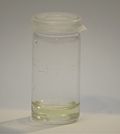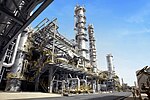Isoprene, or 2-methyl-1,3-butadiene, is a common volatile organic compound with the formula CH2=C(CH3)−CH=CH2. In its pure form it is a colorless volatile...
18 KB (1,884 words) - 22:51, 1 January 2025
Terpene (redirect from Isoprene rule)
solids. Conceptually derived from isoprenes, the structures and formulas of terpenes follow the biogenetic isoprene rule or the C5 rule, as described...
32 KB (3,488 words) - 12:31, 4 January 2025
The enzyme isoprene synthase (EC 4.2.3.27) catalyzes the chemical reaction prenyl pyrophosphate ⇌ {\displaystyle \rightleftharpoons } isoprene + diphosphate...
4 KB (479 words) - 14:37, 26 August 2023
Triterpenes are a class of terpenes composed of six isoprene units with the molecular formula C30H48; they may also be thought of as consisting of three...
5 KB (509 words) - 14:51, 30 April 2023
distinct types of biochemical subunits or "building-blocks": ketoacyl and isoprene groups. Using this approach, lipids may be divided into eight categories:...
71 KB (7,366 words) - 11:48, 3 January 2025
Oak trees produce a haze of isoprene, which helps give the Blue Ridge Mountains their signature color....
281 KB (24,676 words) - 06:28, 13 January 2025
naturally occurring organic chemicals derived from the 5-carbon compound isoprene and its derivatives called terpenes, diterpenes, etc. While sometimes used...
11 KB (913 words) - 19:44, 24 October 2024
without decomposition, although at elevated temperatures it cracks to form isoprene. It oxidizes easily in moist air to produce carveol, carvone, and limonene...
20 KB (1,584 words) - 18:09, 14 January 2025
caoutchouc, as initially produced, consists of polymers of the organic compound isoprene, with minor impurities of other organic compounds. Types of polyisoprene...
61 KB (7,051 words) - 14:48, 14 January 2025
Methacrylonitrile (redirect from Isoprene cyanide)
Methacrylonitrile (or 2-Methylprop-2-enenitrile), MeAN in short, is a chemical compound that is an unsaturated aliphatic nitrile, widely used in the preparation...
13 KB (1,696 words) - 17:38, 5 September 2022
important reaction that uses these activated isoprene donors is sterol biosynthesis. Here, the isoprene units are joined to make squalene and then folded...
113 KB (12,371 words) - 16:51, 16 December 2024
Monoterpenes are a class of terpenes that consist of two isoprene units and have the molecular formula C10H16. Monoterpenes may be linear (acyclic) or...
16 KB (1,634 words) - 02:46, 23 August 2024
synthetic rubber, a copolymer of isobutylene with isoprene. The abbreviation IIR stands for isobutylene isoprene rubber. Polyisobutylene, also known as "PIB"...
13 KB (1,522 words) - 14:41, 30 August 2024
rubber to the point that chemical reactions form disulfide bridges between isoprene units of the polymer. This process, patented in 1843,[citation needed]...
99 KB (11,029 words) - 16:34, 6 January 2025
of isoprene. In practice polyisoprene is commonly used to refer to synthetic cis-1,4-polyisoprene, made by the industrial polymerisation of isoprene. Natural...
5 KB (502 words) - 19:27, 10 July 2024
and trans-1,4-polyisoprene gutta-percha Synthetic polyisoprene (IR for isoprene rubber) Polybutadiene (BR for butadiene rubber) Chloroprene rubber (CR)...
10 KB (972 words) - 11:47, 13 September 2024
isobutylene, isoprene, chloroprene; elastomeric polymers are often made with a high percentage of conjugated diene monomers such as 1,3-butadiene, isoprene, or...
20 KB (2,073 words) - 03:17, 14 January 2025
v t e Types of terpenes and terpenoids (# of isoprene units) Basic forms: Acyclic (linear, cis and trans forms) Monocyclic (single ring) Bicyclic (2 rings)...
85 KB (9,472 words) - 03:53, 2 January 2025
when seen from a distance. Trees put the "blue" in Blue Ridge, from the isoprene released into the atmosphere. This contributes to the characteristic haze...
18 KB (1,574 words) - 05:47, 12 January 2025
which are terpenoids (isoprenoids), synthesized biochemically from eight isoprene units and thus having 40 carbons. Dietary β-carotene is a provitamin A...
34 KB (3,540 words) - 02:03, 12 January 2025
the Bayer laboratory in Elberfeld, Germany, succeeded in polymerizing isoprene, making the first synthetic rubber. Studies published in 1930 written independently...
10 KB (1,178 words) - 01:29, 2 January 2025
The majority of VOCs are produced by plants, the main compound being isoprene. Small amounts of VOCs are produced by animals and microbes. Many VOCs...
71 KB (7,747 words) - 18:48, 12 January 2025
10-carbon terpene units, which in turn were formed from eight 5-carbon isoprene units. Intermediate steps are the creation of a 40-carbon phytoene molecule...
114 KB (12,980 words) - 07:53, 14 January 2025
production through the Krebs cycle, and produces isoprene, the most common hydrocarbon in animals. Isoprenes in animals form the important steroid structural...
39 KB (4,361 words) - 20:27, 14 January 2025
the production of harmful volatile organic compounds, like isoprenes. The emission of isoprenes into the air, by plants, can severely impact the environment...
137 KB (15,826 words) - 20:10, 13 January 2025
success." The dissertation is titled the "Stereospecific Polymerization of Isoprene" and has substantial scientific value, still cited today. Elena Ceausescu...
25 KB (2,416 words) - 04:41, 8 January 2025
from six to ten subunits in the tail, with humans having a tail of 10 isoprene units (50 carbon atoms) connected to its benzoquinone "head". This family...
49 KB (4,901 words) - 14:44, 7 January 2025
are derivatives of tetraterpenes, meaning that they are produced from 8 isoprene units and contain 40 carbon atoms. In general, carotenoids absorb wavelengths...
44 KB (5,282 words) - 02:45, 2 November 2024























